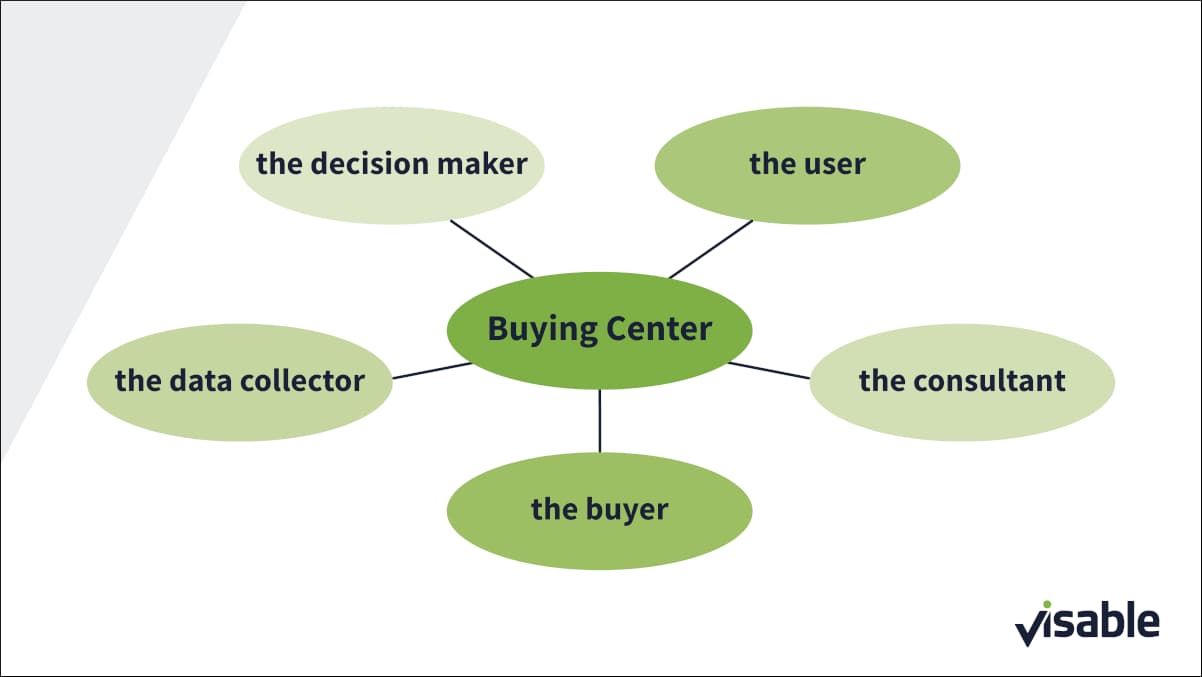Large-scale purchases in the B2B field have to be well thought through. Which is why so-called buying centres often make the important purchasing decisions. This makes the centre’s members a key target group. As a strong team, Marketing and Sales can optimally address them. Read here how.

What is a buying centre?
Purchasing decisions within the B2B sector have huge consequences. Usually, the discussion is about costs, but also about the implementation of a long-term strategy or a fundamental technological direction for the future. Because a lot is riding on the decision, companies frequently spread out this responsibility over many shoulders. A group, known as a buying centre, determines which materials are purchased for manufacturing or who is commissioned to provide a service.
As its members have an enormous influence, they are important players in the B2B business and deserve special consideration within the customer journey. This especially poses a challenge for Marketing and Sales. Both teams should cater to the members of the buying centre of the (potential) B2B business partner in a targeted way. It therefore makes sense to collaborate.

The role of the B2B buying centre
As purchasing decisions often affect various departments, the composition of a buying centre may change, with varying members and their numbers. Depending on their respective skills and functions, which make sense to include within a tendering process, the distribution of tasks may also often change amongst the participants. However, what usually remains the same despite the rotating employees: certain roles within the buying centre. Each can be individually addressed:
- The user is the one who works with the product or service ordered on a daily basis. This doesn’t mean he decides on the purchase, but he can contribute his hands-on experience to the buying centre and thus influence their decision. His interest is in the concrete application and use. This makes him receptive to tips on handling. What’s more, he would like a partner who can quickly answer his questions.
- The data collector gathers information about the purchasing object and gives this information to the relevant areas. He also usually does not directly decide on the purchase. But he chooses who in the buying centre is entrusted with which data. Therefore, he has a medium level of influence at the least. Data collectors can often be found as assistants to managing directors. So that they can achieve their tasks, you should supply them with the matching content in the form of white papers or demonstrations.
- The buyer takes care of the practical aspects of investments. He selects, for instance, suppliers, negotiates discounts and is responsible for the terms and conditions of contracts. To achieve this, he has to calculate the value for money and generate a risk assessment. Which is why it pays off to give arguments such as money-back guarantees, binding delivery dates, all-inclusive deals or greater transparency.
- The consultant is focused on a high-quality solution. He supports the buying centre with specialist competence and background knowledge. As he needs a complete overview, he should be provided with comprehensive information. This requires employees from Marketing and Sales who have a lot of knowledge and can offer more in-depth business data on request. Because a consultant is often active as an external support, and thus does not belong to the company, it is often difficult for him to make decisions for Marketing and Sales.
- The decision-maker acts in the best interests of the company and its profitability. He is less interested in details and more focused improved efficiency and effective processes. Which is why the ultimate benefit of an offer speaks to him the most. He is convinced by references, facts and practicality.

Increase your visibility to your target audience and showcase your product offering online by creating a free profile on wlw.
Why content marketing reaches the decision-maker
As personnel usually rotates within a buying centre, it’s not easy to identify its individual members. In this case, a collaboration between Marketing and Sales is highly recommended. Sellers usually know the respective experts in the company who decide on the needs and purchases. And while Sales seeks out the personal contact with decision-makers, B2B Marketing (indirectly) takes care of the other players.
To achieve this, the following insight is helpful: for their tasks, all the members of a buying centre need lots of information. They collect this mainly in the beginning phase of a purchasing process, usually via Google searches. Which is why it’s important to appear as high as possible in the search results. You can achieve this with the right content based on SEO and thanks to a company profile on our B2B platform, Europages, to get backlinks and improve your rankings.
An important tool in this case is marketing automation, amongst others. It automatically publishes the right content on various channels. Especially effective is the use of buyer personas.
